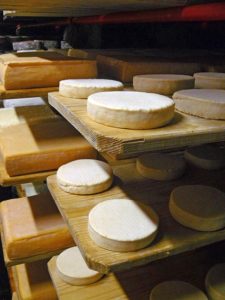
Editor’s Note: This sponsored column is written by Katie Carter, cheesemonger at Arrowine (4508 Lee Highway)
When you walk into a cheese shop and that very particular odor hits your nose, you are most likely smelling the group of cheeses we call the washed rinds. Unlike the gentle fresh and bloomy rinds, this class of cheese offers a wide range of bold, earthy aromas and flavors. We can thank the European monks, specifically the Benedictines, for these whiffy creations.
These monks were part of an order that required a life of hard work, self sufficiency, and poverty. Beer became an important part of that life, as well as dairy farming and cheesemaking. The cheeses they developed often integrated their own beer. After production of a simple rennet coagulated soft or semi-soft cheese, the monks washed the wheels with their beer, a simple brine solution, or distilled spirits.
 The process of continually washing the cheese attracts a common (and edible) airborne bacteria to the surface, growing as a reddish and sticky “smear”. This bacteria, brevibacterium linens, is responsible for this style of cheese’s characteristic aroma and red rind. It also happens to be responsible for smelly feet, which is why people associate this style of cheese with old socks or funky body odors.
The process of continually washing the cheese attracts a common (and edible) airborne bacteria to the surface, growing as a reddish and sticky “smear”. This bacteria, brevibacterium linens, is responsible for this style of cheese’s characteristic aroma and red rind. It also happens to be responsible for smelly feet, which is why people associate this style of cheese with old socks or funky body odors.
Before you get all grossed out, let me state that the aroma of these cheeses are usually much stronger than the actual taste of the cheese (and, again, the rind is perfectly edible).
Today, washed rind cheeses can be made by any cheesemaker as the bacterial linens are commercially manufactured, allowing for better consistency from batch to batch. Most cheesemakers will inoculate the milk with this culture, as well as add it to the brine solution during washing.
Bergfichte
This raw cow’s milk cheese is made by my favorite cheesemaker, Willi Schmid, in Lichtensteig, Switzerland. It is a soft cheese wrapped in spruce bark from local trees. The cheese has an aroma of rosemary and pine due to the bark, with only a slight hint of farmy funk. The rich, creamy paste is in perfect balance with the other elements of this cheese. The Swiss taught me a very cool trick to enjoying this cheese: eat it backwards. Peel off the bark and eat the cheese from the outside in and you will get the full piney goodness that makes this cheese so wonderful.
Hailing from the French Pyrenees, this firm, raw goat’s milk cheese is washed in a local Jurancon wine. Unlike the Loire Valley’s goat cheeses, this rarity has a deep flavor which reminds me of coffee or chocolate. The acidity and herbaceous qualities typical of most goat’s milk cheeses are there but it’s also nutty and slightly meaty.
Taleggio
Taleggio is a classic cow’s milk washed rind cheese from Lombardy, Italy. It is a perfect intro to the world of washed rinds. Washed in a brine solution, this cheese has a soft yet thick paste that is salty, creamy, and meaty. Try it in the next month or so and the cheese will have a hint of truffles.
Also look out for Grayson, Virginia’s most famous cheese. It is a beautifully funky raw cow’s milk cheese made seasonally on a small farm down in Galax.
Stay funky, Arlington!
Katie Carter is Arlington’s first and only ACS Certified Cheese Professional. She has worked in the cheese industry for ten years as a cheesemaker, cheesemonger, and educator. She can be found on Twitter @AfinaCheese. The views and opinions expressed in the column are those of the author and do not necessarily reflect the views of ARLnow.com.


